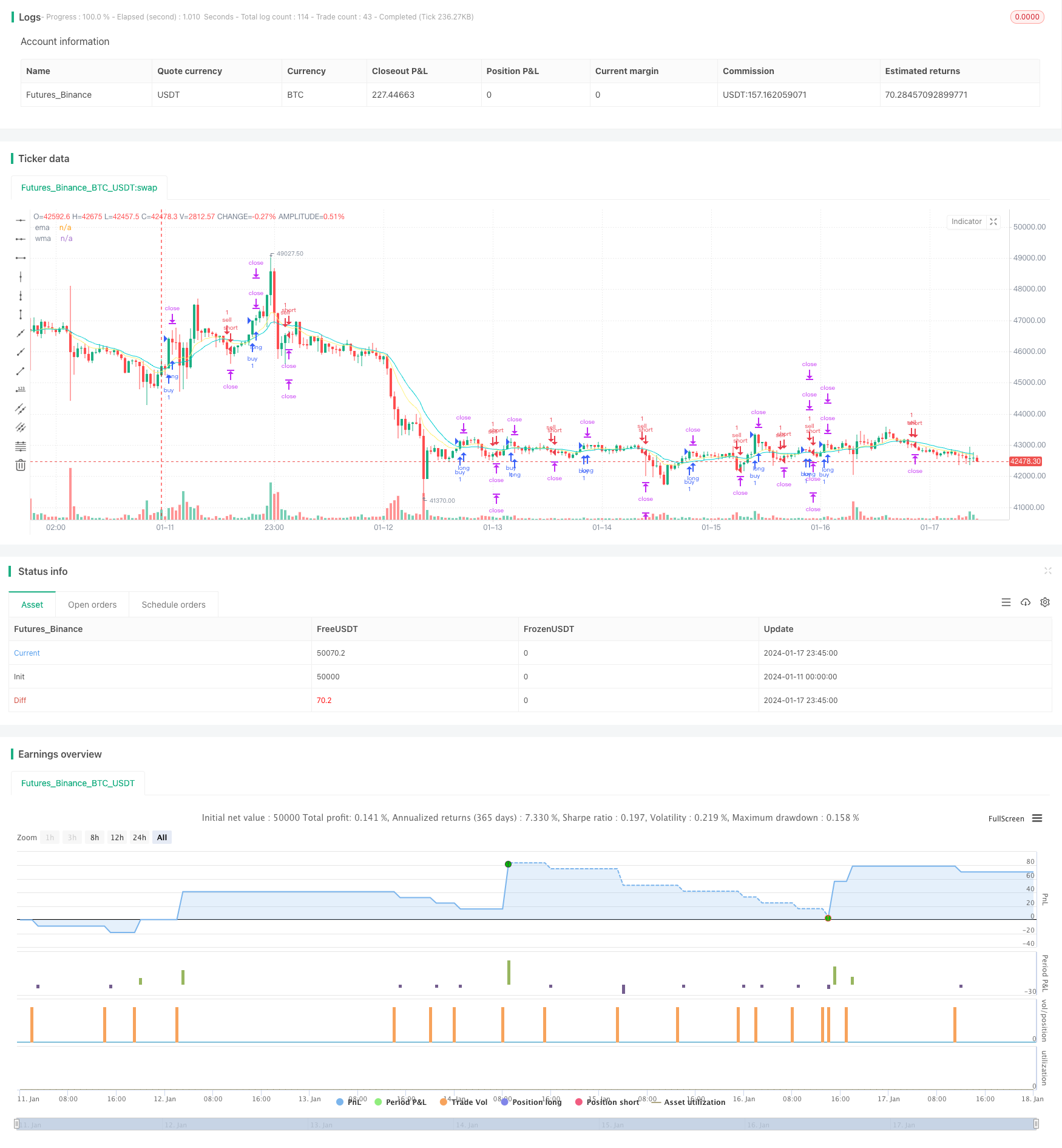
概述
本策略是一个基于双止盈、双止损和移动止损的比特币量化交易策略。该策略通过EMA和WMA的交叉作为入场信号,采取双止盈双止损的风险管理方法,在第一个止盈点达到后,采取移动止损保证部分利润,继续追求更大利润。
策略原理
当EMA从下方上穿WMA时,做多入场;当EMA从上方下穿WMA时,做空入场。
止盈方面,设定两个止盈点,第一个止盈点设置为入场点之上20个点,第二个止盈点设置为入场点之上40个点。
止损方面,同样设定两个止损点,第一个止损点设置为入场点之下20个点,第二个止损点设置为入场点本身。
当价格首先触及第一个止盈点时,平掉50%的头寸,并把止损点移至入场点,继续追求第二个止盈点的更大利润。
这样,该策略会有三种结果:
1. 价格首先触及止损点,损失2%本金;
2. 价格首先触及第一个止盈点,获得1%利润,之后触及第二个止损点,最终获得1%利润;
3. 价格首先触及第一个止盈点,获得1%利润,之后继续运行触及第二个止盈点,最终获得3%利润。
优势分析
该策略最大的优势在于风险管理体系。通过设置双止盈双止损,可以在获得部分利润后,采取移动止损来锁定利润,继续追求更大利润。这可以显著提高盈利能力。
另一个优势是,该策略将单次交易的结果细分为三种情况,降低了单次损失的概率,使整体收益更加平稳。普通策略只有两种结果,要么止损掉2%,要么获得比2%更大的盈利。而本策略有三种结果,分别是损失2%、获得1%和获得3%。这也更好地控制了尾部风险。
风险分析
本策略的风险主要来自止损点的设置。止损距离过于宽松,可能导致单次损失过大;而止损距离过于狭窄,则容易被市场噪音击出。这需要根据不同品种的特性和波动率来设定合适的止损距离。
另一个风险是在第一个止盈点后仍持有头寸的部分存在亏损风险。如果亏损超过第一个止盈的利润,会抵消掉部分或全部利润。这需要严格执行移动止损来锁定利润。
优化方向
本策略可以从以下几个方面进行优化:
测试不同的参数组合,寻找最优的参数设置。例如可以测试15个点、25个点的止盈止损距离。
尝试其他指标组合,如KDJ、MACD等的指标信号来决定入场。
对第一个止盈点平仓的仓位比例进行优化,是50%适合还是30%或70%更优。
测试移动止损的跟踪速度设置,确保在保证盈利的前提下尽可能缩小亏损空间。
总结
本策略整体来说非常稳健,通过双止盈双止损和移动止损,可以显著提高盈利水平,降低尾部风险。优化的空间也比较大,通过参数调整和指标组合还可以获得更好的效果。总的来说,本策略适合那些追求高额稳定收益的投资者。
/*backtest
start: 2024-01-11 00:00:00
end: 2024-01-18 00:00:00
period: 45m
basePeriod: 5m
exchanges: [{"eid":"Futures_Binance","currency":"BTC_USDT"}]
*/
//@version=4
strategy("SL1 Pips after TP1 (MA)", commission_type=strategy.commission.cash_per_order, overlay=true)
// Strategy
Buy = input(true)
Sell = input(true)
// Date Range
start_year = input(title='Start year' ,defval=2020)
start_month = input(title='Start month' ,defval=1)
start_day = input(title='Start day' ,defval=1)
start_hour = input(title='Start hour' ,defval=0)
start_minute = input(title='Start minute' ,defval=0)
end_time = input(title='set end time?',defval=false)
end_year = input(title='end year' ,defval=2019)
end_month = input(title='end month' ,defval=12)
end_day = input(title='end day' ,defval=31)
end_hour = input(title='end hour' ,defval=23)
end_minute = input(title='end minute' ,defval=59)
// MA
ema_period = input(title='EMA period',defval=10)
wma_period = input(title='WMA period',defval=20)
ema = ema(close,ema_period)
wma = wma(close,wma_period)
// Entry Condition
buy =
crossover(ema,wma) and
nz(strategy.position_size) == 0 and Buy
sell =
crossunder(ema,wma) and
nz(strategy.position_size) == 0 and Sell
// Pips
pip = input(20)*10*syminfo.mintick
// Trading parameters //
var bool LS = na
var bool SS = na
var float EP = na
var float TVL = na
var float TVS = na
var float TSL = na
var float TSS = na
var float TP1 = na
var float TP2 = na
var float SL1 = na
var float SL2 = na
if buy or sell and strategy.position_size == 0
EP := close
SL1 := EP - pip * (sell?-1:1)
SL2 := EP - pip * (sell?-1:1)
TP1 := EP + pip * (sell?-1:1)
TP2 := EP + pip * 2 * (sell?-1:1)
// current trade direction
LS := buy or strategy.position_size > 0
SS := sell or strategy.position_size < 0
// adjust trade parameters and trailing stop calculations
TVL := max(TP1,open) - pip[1]
TVS := min(TP1,open) + pip[1]
TSL := open[1] > TSL[1] ? max(TVL,TSL[1]):TVL
TSS := open[1] < TSS[1] ? min(TVS,TSS[1]):TVS
if LS and high > TP1
if open <= TP1
SL2:=min(EP,TSL)
if SS and low < TP1
if open >= TP1
SL2:=max(EP,TSS)
// Closing conditions
close_long = LS and open < SL2
close_short = SS and open > SL2
// Buy
strategy.entry("buy" , strategy.long, when=buy and not SS)
strategy.exit ("exit1", from_entry="buy", stop=SL1, limit=TP1, qty_percent=1)
strategy.exit ("exit2", from_entry="buy", stop=SL2, limit=TP2)
// Sell
strategy.entry("sell" , strategy.short, when=sell and not LS)
strategy.exit ("exit3", from_entry="sell", stop=SL1, limit=TP1, qty_percent=1)
strategy.exit ("exit4", from_entry="sell", stop=SL2, limit=TP2)
// Plots
a=plot(strategy.position_size > 0 ? SL1 : na, color=#dc143c, style=plot.style_linebr)
b=plot(strategy.position_size < 0 ? SL1 : na, color=#dc143c, style=plot.style_linebr)
c=plot(strategy.position_size > 0 ? TP1 : na, color=#00ced1, style=plot.style_linebr)
d=plot(strategy.position_size < 0 ? TP1 : na, color=#00ced1, style=plot.style_linebr)
e=plot(strategy.position_size > 0 ? TP2 : na, color=#00ced1, style=plot.style_linebr)
f=plot(strategy.position_size < 0 ? TP2 : na, color=#00ced1, style=plot.style_linebr)
g=plot(strategy.position_size >= 0 ? na : EP, color=#ffffff, style=plot.style_linebr)
h=plot(strategy.position_size <= 0 ? na : EP, color=#ffffff, style=plot.style_linebr)
plot(ema,title="ema",color=#fff176)
plot(wma,title="wma",color=#00ced1)